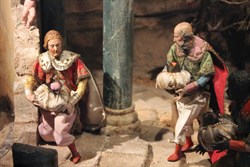Neapolitan Nativity scenes of the Spanish nobility (I)
 If in the eighteenth century the taste for Neapolitan nativity scene represented a distraction in the life of the palace, today the Nativity scene can be luxurious objects, authentic works of art, preserved, restored and exhibited in major national museums. This is the case, for example, of the Museo de Historia de MadridThe Museo de Historia de Madrid (Museum of the History of Madrid) recounts the history of Madrid – through a collection of maps, paintings and various objects – since Philip II converted it into the capital of his vast monarchy in the sixteenth century. It is located in calle Fuencarral, and the building has one of the most important Baroque façades of Madrid. (Museum of the History of Madrid), which has managed to gather a good number of Neapolitan figures of the eighteenth century from collections belonging to Spanish nobles who, imitating the passion of the royal family, had commissioned the construction of elegant figures for Nativity scenes to famous Neapolitan sculptors of the period. Although no one knows to which noble they belonged to, the Neapolitan Nativity scene at the Museo de Historia is one of the most famous and visited in Madrid.
If in the eighteenth century the taste for Neapolitan nativity scene represented a distraction in the life of the palace, today the Nativity scene can be luxurious objects, authentic works of art, preserved, restored and exhibited in major national museums. This is the case, for example, of the Museo de Historia de MadridThe Museo de Historia de Madrid (Museum of the History of Madrid) recounts the history of Madrid – through a collection of maps, paintings and various objects – since Philip II converted it into the capital of his vast monarchy in the sixteenth century. It is located in calle Fuencarral, and the building has one of the most important Baroque façades of Madrid. (Museum of the History of Madrid), which has managed to gather a good number of Neapolitan figures of the eighteenth century from collections belonging to Spanish nobles who, imitating the passion of the royal family, had commissioned the construction of elegant figures for Nativity scenes to famous Neapolitan sculptors of the period. Although no one knows to which noble they belonged to, the Neapolitan Nativity scene at the Museo de Historia is one of the most famous and visited in Madrid.
Every year the same representation is mounted in the museum, in which the pomp and the ostentation of the ceremonies of the court of Naples mingle with the scene of the ancient city of Bethlehem. To create the ambiance and imitate reality in the eyes of contemporaries of the eighteenth century, Roman columns were added, thus following the classical taste of the time and also the cultural impact of the discovery of Pompeii, which was a model for the representation of ancient Bethlehem. Hence the anachronistic juxtaposition between the Magi and scenes from the life of the Neapolitan people was not perceived as a problem.
 The identity of the author of this Nativity scene is unknown, though the accuracy of the technique and the realism of the figures suggests that it was – and this is indicated by the Museum – by Giuseppe SammartinoGiuseppe Sammartino (1720-1793) was an important Italian sculptor, a leading figure in the art scene of eighteenth century Naples. His most famous work is undoubtedly the marble Veiled Christ made for the chapel of the Princes of Sangro di San Severo in Naples, the Cappella San Severo. But in his long career Sammartino was the author of other great works, such as the decoration of the altar of the Church of the Nunziatella (Annunciation). He was also a creator of Nativity scenes. or Francesco CelebranoFrancesco Celebrano (1729-1814) was a sculptor and painter in the service of Ferdinand IV of Bourbon, a great decorator of porcelain and author of an important production of Nativity scenes. . All figures are adjoining, which allows for better representation and a greater variety of movement. Silk fabrics were used for the clothes and silver, according to Neapolitan etiquette, for accessories and jewelry. These identified and characterized the figures, defining at the same time, the rungs on the social ladder. The appearance of buffalo in these Spanish Nativity scenes is curious, a clear sign of the legacy of the Neapolitan scene: in fact these animals were not reared in Spain at the time and were therefore not easily recognizable to the Iberian eighteenth century viewer.
The identity of the author of this Nativity scene is unknown, though the accuracy of the technique and the realism of the figures suggests that it was – and this is indicated by the Museum – by Giuseppe SammartinoGiuseppe Sammartino (1720-1793) was an important Italian sculptor, a leading figure in the art scene of eighteenth century Naples. His most famous work is undoubtedly the marble Veiled Christ made for the chapel of the Princes of Sangro di San Severo in Naples, the Cappella San Severo. But in his long career Sammartino was the author of other great works, such as the decoration of the altar of the Church of the Nunziatella (Annunciation). He was also a creator of Nativity scenes. or Francesco CelebranoFrancesco Celebrano (1729-1814) was a sculptor and painter in the service of Ferdinand IV of Bourbon, a great decorator of porcelain and author of an important production of Nativity scenes. . All figures are adjoining, which allows for better representation and a greater variety of movement. Silk fabrics were used for the clothes and silver, according to Neapolitan etiquette, for accessories and jewelry. These identified and characterized the figures, defining at the same time, the rungs on the social ladder. The appearance of buffalo in these Spanish Nativity scenes is curious, a clear sign of the legacy of the Neapolitan scene: in fact these animals were not reared in Spain at the time and were therefore not easily recognizable to the Iberian eighteenth century viewer.
